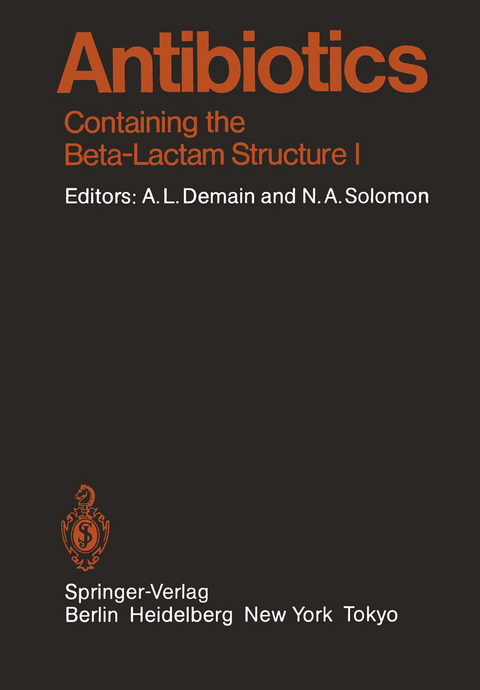
Antibiotics
Springer Berlin (Verlag)
978-3-642-81968-1 (ISBN)
1 History of ?-Lactam Antibiotics.- A. The Past Fifty Years.- B. The Future.- References.- 2 Mode of Action of ?-Lactam Antibiotics - A Microbiologist's View.- A. Introduction.- B. Journey of the Extracellular Antibiotic to the Intracellular Targets.- C. The Biochemical Targets of ?-Lactam Antibiotics.- D. Physiological Consequences of ?-Lactam Inhibition.- E. Variations in the Physiological Effects of Penicillins.- F. Environmental Factors That Modulate the Antibacterial Effects of Penicillin.- G. Conclusion.- References.- 3 Strain Improvement and Preservation of ?-Lactam-Producing Microorganisms.- A. Introduction.- B. Distribution of ?-Lactam Antibiotics and Related Metabolites in Nature.- C. Strain Improvement Programs in Commercially Important ?-Lactam Fermentation Organisms.- D. Actinomycetes Producing New ?-Lactam Antibiotics.- E. Unicellular Bacteria Producing Sulfazecins and Related Structures.- F. Maintenance and Long-Term Preservation of Strains of Penicillium chrysogenum and Acremonium chrysogenum.- References.- 4 Genetics of ?-Lactam-Producing Fungi.- A. Introduction.- B. Aspergillus nidulans.- C. Penicillium chrysogenum.- D. Cephalosporium acremonium.- E. Recombination Between Naturally Incompatible Fungi.- References.- 5 Genetics of ?-Lactam-Producing Actinomycetes.- A. Introduction.- B. ?-Lactam Antibiotics and the Actinomycetales.- C. Streptomyces Genetics.- D. Antibiotic Production in Actinomycetes.- E. The Genetics of ?-Lactam Antibiotics and the Future.- References.- 6 Biosynthesis of ?-Lactam Antibiotics.- A. Introduction.- B. Hydrophobic ?-Lactam Antibiotics.- C. Hydrophilic ?-Lactam Antibiotics.- D. Antibiotic Production by Pairs of Blocked Mutants.- E. Novel ?-Lactam Antibiotics.- References.- 7 Regulation of Biosynthesis of?-Lactam Antibiotics.- A. Introduction.- B. Carbon Catabolite Regulation.- C. Nitrogen Metabolite Regulation.- D. Regulation at the Level of Sulfur Metabolism.- E. Lysine Metabolism and Antibiotic Biosynthesis.- F. Control of ?-Lactam Specific Enzymes at the Level of Secondary Metabolism.- G. End-Product Regulation.- H. Summary and Future Outlook.- References.- 8 Biochemical Engineering and ?-Lactam Antibiotic Production.- A. Introduction.- B. Penicillin Fermentation - Current Status.- C. Growth Monitoring and Control - Method of Approach.- D. Effect of Growth on Penicillin Production.- E. Effect of the Use of Corn-Steep Liquor.- F. Maintenance Demand as a Fermentation Variable.- G. Overall Conversion Yield of Glucose to Penicillin- Ppis.- H. Summary.- References.- 9 Screening for New ?-Lactam Antibiotics.- A. Introduction.- B. Rationale for Screening of ?-Lactam Antibiotics.- C. Finding ?-Lactam-Producing Microorganisms.- D. Screening Systems Which Detect ?-Lactams.- E. Future Trends.- F. A Hypothetical Screening Model.- References.- 10 High-Performance Liquid Chromatography of ?-Lactam Antibiotics.- A. Introduction.- B. Penicillin Antibiotics.- C. Cephalosporin Antibiotics.- D. Other ?-Lactam Compounds.- E. Oxy-?-L actams.- F. Concluding Remarks.- References.- 11 Strategy in the Total Synthesis of ?-Lactam Antibiotics.- A. Introduction.- B. ?-Lactam Closure.- C. 2+2 Annelations.- D. Monocyclic ?-Lactam Antibiotics.- E. Examples Involving Prior Construction of the Azetidinone.- F. Penicillin Total Synthesis - Sheehan.- G. Cefoxitin Total Synthesis - Merck.- H. Nocardicin Total Synthesis - Wasserman.- I. Total Synthesis of (±)-Clavulanic Acid - Beecham.- J. Cephalosporin C Total Synthesis - Woodward.- K. Penicillin Total Synthesis -Baldwin.- L. Synthesis of the Penem Nucleus - Woodward.- M. Total Synthesis of (+)-Thienamycin - Merck.- N. Conclusion.- References.
| Erscheint lt. Verlag | 8.12.2011 |
|---|---|
| Reihe/Serie | Handbook of Experimental Pharmacology |
| Zusatzinfo | XVIII, 360 p. |
| Verlagsort | Berlin |
| Sprache | englisch |
| Maße | 170 x 244 mm |
| Gewicht | 660 g |
| Themenwelt | Medizin / Pharmazie ► Medizinische Fachgebiete ► Pharmakologie / Pharmakotherapie |
| Medizin / Pharmazie ► Pharmazie ► PTA / PKA | |
| Schlagworte | Antibiotics • Bacteria • Blood • Chemotherapy • Chromatography • Genetics • Infection • Membrane • Metabolism • Methodology • Mutagenesis • Peptides • proteins • resistance • Structure • Toxicity |
| ISBN-10 | 3-642-81968-0 / 3642819680 |
| ISBN-13 | 978-3-642-81968-1 / 9783642819681 |
| Zustand | Neuware |
| Haben Sie eine Frage zum Produkt? |
aus dem Bereich


